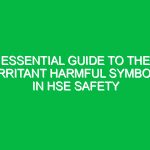Introduction
In the realm of Health, Safety, and Environment (HSE) compliance, symbols play a crucial role in conveying important information about potential Hazards. Among these symbols, one particularly concerning category is the irritating symbol. This designation refers to substances or situations that may cause irritation to the skin, eyes, or respiratory system. The relevance of the irritating symbol in HSE cannot be overstated, as it serves not only as a warning but also as a guide for safe handling and emergency response actions.
Understanding the implications of the irritating symbol is essential for workers, employers, and Safety professionals alike. Misinterpretation or disregard of this symbol can lead to serious health risks and accidents in the workplace. This article will delve into the intricacies of the irritating symbol within the HSE framework, exploring its significance, the potential dangers it represents, and Best Practices for compliance.
The Importance of the Irritating Symbol in HSE
Defining the Irritating Symbol
The irritating symbol is officially recognized as a yellow triangle with an exclamation mark, often accompanied by the phrase “Irritant” or relevant hazard information. This symbol indicates substances that, while not classified as corrosive or toxic, can still cause mild to moderate irritation upon contact or inhalation. Common examples include certain chemicals found in cleaning products, paints, and industrial solvents.
The presence of the irritating symbol serves multiple purposes. First, it alerts individuals to the potential risks associated with the substance. Second, it encourages the implementation of Safety Measures to mitigate exposure. Finally, it fosters a culture of Safety awareness, prompting employees to be vigilant regarding their surroundings and the materials they handle.
Key Aspects of the Irritating Symbol
1. Recognition and Understanding
Recognizing the irritating symbol is the first step in ensuring safety. Workers must be trained to identify this symbol on labels and safety data sheets (SDS). Familiarity with the symbol allows employees to take appropriate Precautions, such as wearing Personal Protective Equipment (PPE) or ensuring proper ventilation in work areas.
2. Risks Associated with Irritating Substances
Ignoring the irritating symbol can lead to various health issues. Prolonged exposure to irritants can result in skin rashes, eye irritation, and respiratory difficulties. For instance, a worker exposed to a cleaning agent without adequate protection may experience dermatitis or conjunctivitis. Furthermore, the cumulative Effects of repeated exposure can increase the severity of these reactions over time.
3. Compliance with Safety Standards
Compliance with local and international safety standards is paramount in mitigating the risks associated with irritating symbols. Regulations such as the Globally Harmonized System of Classification and Labelling of Chemicals (GHS) and Occupational Safety and Health Administration (OSHA) guidelines outline the requirements for labeling hazardous substances, including those marked with the irritating symbol. Adhering to these Regulations not only ensures legal compliance but also enhances Workplace Safety.
Implementing Best Practices for Managing Irritating Symbols
1. Conducting Risk Assessments
Before utilizing any substance marked with the irritating symbol, employers should conduct thorough risk assessments. This process involves identifying potential Hazards, evaluating the likelihood of exposure, and implementing Control Measures to minimize risks. Regular reviews of these assessments ensure ongoing safety.
2. Proper Labeling and Signage
Effective communication is key to HSE compliance. All containers holding irritating substances must be clearly labeled, displaying the irritating symbol prominently. Additionally, signage in work areas should reinforce the message, reminding workers of the hazards and necessary Precautions.
3. Providing Training and Resources
Training programs should educate employees about the risks associated with irritating substances and the meaning of the irritating symbol. Providing access to SDS and safety manuals empowers workers to make informed decisions regarding their safety. Regular refresher courses help maintain awareness and reinforce Safe Practices.
4. Ensuring Availability of PPE
Personal protective equipment is a frontline defense against the risks posed by irritating substances. Employers must ensure that appropriate PPE, such as gloves, goggles, and respirators, is readily available and that workers are trained in its proper use. Regular inspections of PPE should be conducted to ensure it remains in good condition.
5. Establishing Emergency Procedures
In the event of exposure to an irritant, immediate action can significantly reduce health risks. Establishing clear emergency procedures, including first aid measures and reporting protocols, is essential. Workers should be familiar with these procedures and know how to access emergency equipment, such as eyewash stations and safety showers.
Real-Life Examples of Irritating Symbol Mismanagement
To illustrate the potential dangers associated with the irritating symbol, consider the following hypothetical scenario:
A manufacturing plant that produces cleaning agents neglected to properly label a new chemical formulation. The product contained a significant amount of an irritant, yet the personnel were unaware of this due to the absence of the irritating symbol on the label. One employee, tasked with mixing chemicals, experienced severe eye irritation after splashing the substance. The company faced not only medical expenses but also legal repercussions due to non-compliance with labeling regulations.
This example underscores the importance of proper labeling and employee training in preventing incidents related to the irritating symbol. It also highlights the potential financial implications of negligence in HSE compliance.
Regulatory Framework Surrounding the Irritating Symbol
1. osha Regulations
The Occupational Safety and Health Administration (OSHA) enforces regulations that govern Workplace Safety, including the handling of hazardous materials. The Hazard Communication Standard (HCS) mandates that employers inform workers about the hazards associated with chemicals they may encounter, including those marked with the irritating symbol.
2. GHS Guidelines
The Globally Harmonized System of Classification and Labelling of Chemicals (GHS) standardizes hazard communication, ensuring that workers worldwide receive consistent information about chemical hazards. The GHS specifically outlines criteria for labeling irritants, reinforcing the need for clear and accurate communication.
3. Environmental Regulations
In addition to Workplace Safety regulations, environmental laws may also govern the use of irritating substances. Compliance with regulations such as the Environmental Protection Agency (EPA) guidelines is crucial for organizations that handle chemicals deemed harmful to the environment. These regulations often require proper disposal methods and reporting of chemical releases.
Conclusion
The irritating symbol serves as a vital warning within the HSE domain, highlighting the potential risks associated with certain substances. By understanding its significance, implementing best practices, and adhering to relevant regulations, organizations can effectively manage the dangers posed by irritants.
To foster a culture of safety, ongoing training and communication are essential. The consequences of neglecting the irritating symbol can be severe, impacting not only individual health but also organizational integrity. Therefore, it is imperative for employers and employees alike to remain vigilant and committed to HSE compliance, ensuring a safer working environment for everyone.
In conclusion, the irritating symbol is more than just a warning; it represents a commitment to health, safety, and environmental Sustainability. As industries continue to evolve, so too must our approach to risk management and safety compliance. Embracing proactive measures can lead to a healthier, more secure workplace for all.


